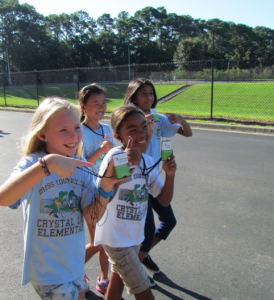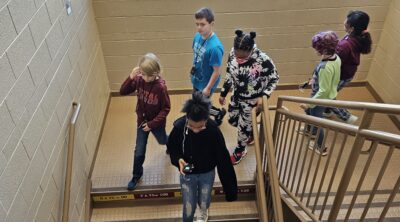You’ve started off the school year smoothly. Classroom expectations have been clearly conveyed. You’re well underway with The Walking Classroom, and you’re hopeful that you’ll continue to hit the trail without a hitch.
And then . . . despite all your best efforts . . . it happens. Perhaps it’s the excitement of the holiday season, or perhaps the planets are simply not aligned. Who knows what the root of it is. All you know is that the idyllic image you were so used to is suddenly a fuzzy fantasy thanks to a student’s less than stellar behavior. How do you handle the hampering that’s happening? We can help you out with some best practices we’ve compiled from adopters past and present.
First and Foremost, Keep the Faith!
Be bolstered by what is known about the benefits of physical activity! Everyone knows that regular exercise is good for the body. Research has shown that it is good for the mind as well! There is strong evidence for a positive link between exercise and cognitive function.
 In addition, research reveals that exercise is also one of the most effective ways to improve mental health. Regular exercise can relieve stress, improve memory, and boost overall mood. Our adopters’ personal experience with the program says much of the same! Teachers regularly report that students with behavior problems and/or high energy levels feel more settled and ready to keep learning following a walk!
In addition, research reveals that exercise is also one of the most effective ways to improve mental health. Regular exercise can relieve stress, improve memory, and boost overall mood. Our adopters’ personal experience with the program says much of the same! Teachers regularly report that students with behavior problems and/or high energy levels feel more settled and ready to keep learning following a walk!
Perhaps, just the regular repetition of this activity will soften your strong-willed students. Once they do engage, it is often those previously difficult members of your crew who become the strongest proponents (rather than opponents!) of the program.
Some Basic Strategies
Often the students who cause the most trouble in class are the ones who benefit the most from the extra physical activity walking provides. They just may not always realize it!
If, however, some students prove to be untrustworthy or too much of a distraction to other students, you may want to consider these useful strategies:
- Keep the troublesome child next to you as your walking partner. Your proximity will prove most helpful, as you model good walking behavior!
- Give that child the responsibility of mid-range pace car — his or her “job” would be to make sure that the other students are keeping up. Sometimes this added responsibility is all that challenging student needs to rise to the occasion!
- If all else fails, the child may need to wait in another teacher’s classroom while the rest of the class walks. Then you can give him or her a chance to try again at a later time.
Other Issues
![]() Maybe you have some students struggling because they do not enjoy physical activity and are feeling frustrated. Perhaps a conversation around such concerns and follow-up discussion focusing on the benefits of increased physical activity may help these students. Similarly, working toward a class step or mileage goal may inspire such students to try for the sake of the “team”!
Maybe you have some students struggling because they do not enjoy physical activity and are feeling frustrated. Perhaps a conversation around such concerns and follow-up discussion focusing on the benefits of increased physical activity may help these students. Similarly, working toward a class step or mileage goal may inspire such students to try for the sake of the “team”!
Two True Tales
 Finally, don’t think you’re alone in your trials and tribulations! We’ve all faced challenging children in our classrooms. From stubborn souls not interested in participating in the program to those who may have more energy than they (or you!) know what to do with, our adopters have seen it all, and are happy to share those strategies that have helped turn the tide!
Finally, don’t think you’re alone in your trials and tribulations! We’ve all faced challenging children in our classrooms. From stubborn souls not interested in participating in the program to those who may have more energy than they (or you!) know what to do with, our adopters have seen it all, and are happy to share those strategies that have helped turn the tide!






We had something like this . . . we have a few students who were very unhealthy and could not “keep up” with the group in the beginning of the year . . . it was a true struggle for them to keep pace. As the year progressed, they got faster and healthier! We would have one teacher at the front of the line (or a responsible student) to set the pace and then a teacher in the back to keep motivating . . . it worked like a charm!